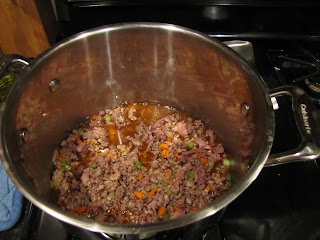I love bolognese sauce. It's so rich and flavorful, and the longer you cook it, the better it gets.
This recipe is the bolognese sauce I cook often, and it has always brought a smile to the faces of those who eat it. It is very rich, and extremely hearty. It's perfect for when the weather starts changing and it starts getting colder, just like this time of year.
What am I talking about? It's good all year long. I made this stuff multiple times during the summer to much fanfare. So try it, it's really not too difficult, you just have to be patient, and let it cook until the liquid has reduced. Once it gets going, don't be tempted to think that it is done. You'll know it's done when the liquid has cooked out and what's left is a wonderful, meaty sauce.
This recipe is adapted from the Lamb Ragu recipe from Andrew Carmellini's Urban Italian cookbook, which is a fantastic book, and highly recommended if you are looking for a good Italian cookbook.
I make it a little different than Carmellini. I use 3 different types of meat, more tomatoes, and slighty different amounts of herbs and spices than he does, but the results are excellent. I find that using a combination of lamb, Italian sausage or ground pork, and either pancetta or prosciutto add a nice extra dimension to the taste.
---
Bolognese Ragu
1 lb. ground lamb
1 lb. ground Italian sausage or pork
2-4 oz pancetta or prosciutto
1/2 cup chopped onion
1/2 cup chopped carrot
1/2 cup chopped celery
1 1/2 tablespoon tomato paste
1 28 oz can peeled organic tomatoes (I used a brand called Cento)
3 cups chicken broth
1 1/2 to 2 cups red wine
2 bay leaves
1/2 teaspoon red pepper flakes
1/2 teaspoon coriander
1/2 teaspoon fennel
3/4 teaspoon cumin
1 1/2 tablespoon thyme
1 1/2 tablespoon rosemary
1 teaspoon salt
Black pepper to taste
First, you brown your meat. Put some olive oil in your pot over medium-high heat and crumble the meat into the pot. Let it cook for a couple minutes, and give it a couple stirs so that it gets brown on all sides.
Next, add in the onions, carrots, and celery, and cook it until it becomes soft, which can take several minutes.
After the vegetables become soft, add the tomato paste and stir it until it is mixed in with the meat and vegetables, and then add the wine. The wine is a key part to this sauce, and you want to reduce it down and let the meat and vegetables absorb that flavor. The wine should reduce down within several minutes if you have the pot hot enough.
After the wine reduces down, add the tomatoes, chicken broth, and all the herbs and spices to the mixture. This is the part where you have to be patient. Turn up the heat until you have the sauce at a low boil, and then reduce it until the sauce is simmering (medium-low heat). And wait....and wait...and wait.
You'll know it's done when the liquid reduces and you are left with a thick, brown, meaty sauce that smells absolutely wonderful. But this will take a long time, probably much longer than you are used to waiting. Usually it takes about 2-3 hours for the sauce to reduce down. This is a good thing. All that time simmering allows the flavors to meld. In the mean time, scrape down the sides and bottom of the pot every once in a while to make sure that nothing is sticking to the pot and burning. You will need to do this often, as you don't want any burnt flavors in the sauce. It is also a good idea to skim any fats floating on the surface of the sauce as well.
When the sauce starts looking like it will soon be done, cook your pasta. After the pasta is cooked, drain it and put it in the pot with the sauce. Add some olive oil and butter, and stir the mixture to combine the pasta and sauce.
Serve the pasta topped with pecorino cheese (parmesan would probably work as well if you can't find pecorino, but get real parmesan and grate it yourself, don't get that powdered crap in the green can).
So there you have it. If you are not a fan of lamb, you can use ground beef if you choose, although I think the lamb is one of the keys to the flavor in this dish.
Next up, back to the Keller recipes, Clams Marinieres with Soffritto from Bouchon.








No comments:
Post a Comment